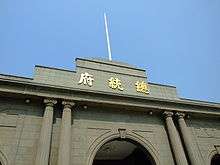Presidential Palace (Nanjing)


The Presidential Palace (simplified Chinese: 总统府; traditional Chinese: 總統府; pinyin: Zǒngtǒng fǔ) in Nanjing, China, housed the Office of the President of the Republic of China since 1927 until the republic was relocated to Taiwan in 1949. It is now a museum, the China Modern History Museum. It is located at 292 Changjiang Road, in the Xuanwu District of Nanjing.
History
Ming and Qing era
In the Ming Dynasty, this house was to the west of the Ming Palace, built by a duke. In the Qing Dynasty, it became the Office of the Viceroy of Liangjiang, the chief government official in charge of what is today Jiangsu, Anhui and Jiangxi.
In 1853, Taiping Revolution forces led by Hong Xiuquan occupied Nanjing. The palace was expanded and converted into a palace for Hong, the Palace of the Heavenly King, or Tianwang Fu.
In 1864, Qing imperial forces re-took Nanjing. Commander Zeng Guofan ordered that most of the palace be razed. He had a new palatial residence and imposing government buildings for the Qing Governor-General erected in the Neoclassical style, and in accordance with contemporary protocol.
Presidential Palace
After the Xinhai Revolution in 1911, Sun Yat-sen was sworn in at the former Governor-General's palace, now the "Presidential Palace," as the provisional President of the Republic of China. He kept offices here for a while.
However, China soon fell into the post-revolution Warlord era, and the Palace was not officially used by the Republic of China (1912-49) until 1927, when the Kuomintang (KMT) Northern Expedition captured Nanjing. As the Nationalist Government, they transformed the Presidential Palace and adjacent buildings into the "Headquarters of the Nationalist Government of the Republic of China." Premier Chiang Kai-shek had his office in the palace.
During the Second Sino-Japanese War (1937–1945), Chiang Kai-shek's government fled to Chongqing, and the Headquarters was occupied by Wang Jingwei, who collaborated with the invading Japanese. Following the Japanese surrender in 1945, Chiang Kai-shek's Nationalist Government reoccupied the Headquarters—Presidential Palace for governing the Republic of China. In 1947, the Constitution of the Republic of China was promulgated. and the "Headquarters of the Nationalist Government of the Republic of China" was renamed the "Presidential Palace."
In April 1949, near the end of the Chinese Civil War, the Communist forces captured Nanjing and the Presidential Palace. Chiang Kai-shek's government fled to Taiwan and Mao Zedong declared the establishment of the People's Republic of China with capital in Beijing on 1 October 1949. The Presidential Palace building was then used for government functions.
Museum
In the late 1980s the former Presidential Palace was transformed into the China Modern History Museum, a history museum exclusively about the 20th century history of modern China, about the history of the Republic of China (1912-1949) and the history of the People's Republic of China.
In 2005, the Chairman of Kuomintang, Lien Chan, visited the museum in the Presidential Palace on his trip to Mainland China, marking a symbolic return of the party to the Palace for the first time in 58 years.
Transportation
The building is accessible within walking distance north of Daxinggong Station of Nanjing Metro.[1]
See also
References
- ↑ "24 hours in Nanjing". cityofnanjing.com.
External links
| Wikimedia Commons has media related to Residence of the President of Republic of China, Nanjing. |
- China Modern History Museum
- Presidential Palace, from Nanjing city government
Coordinates: 32°2′43″N 118°47′32″E / 32.04528°N 118.79222°E
